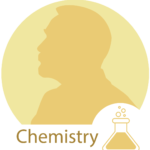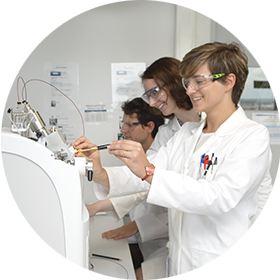Residues and contaminants in the food chain are an increasing problem due to high production volumes, large area distribution and import/export of food items across the world. The novel LESAPLUS surface analysis approach combines the standard liquid extraction surface analysis with an additional step of a nano liquid chromatography separation. This combination is ideally suited to investigate residues and contaminants on surfaces of interest and allows both rapid and direct screening as well as in depth analysis of suspect food samples.
Real-time and near real-time Volatile Organic Compound (VOC) Analysis by vAPCI- Compact Mass Spectrometry
The Loughborough University team has utilized the expression® CMS vAPCI source for a variety of applications including breath analysis, monitoring flavor and fragrance, plant metabolomics, food authenticity and spoilage, and microbiological monitoring. With the use of the expression® CMS, the team was able to successfully execute detection required for these applications quickly and easily.
Determination of emerging nitrogenous economic adulterants in milk proteins by high-performance liquid chromatography/compact mass spectrometry
J. Draher, S. Ehling, N. Cellar, T. Reddy, J. Henion, N. Sousou Rapid Commun. Mass Spectrom. 2016, 30, 1265–1272
Milk-derived ingredients are widely used around the world in the manufacturing of nutritional products. They are prone to economically motivated adulteration with nitrogenous compounds such as melamine and its analogs in order to increase the nitrogen content of these ingredients. The need to rapidly screen milk-derived ingredients to detect adulteration is of paramount public health concern. A liquid chromatography/mass spectrometry (LC/MS)-based method using a single quadrupole mass spectrometer has been developed for the rapid frontline analysis of six nitrogenous protein adulterants, i.e. melamine, ammeline, ammelide, amidinourea, cyromazine and cyanuric acid, in three key milk-derived ingredients, i.e. whole milk powder, nonfat milk powder and whey protein concentrate.
Benjamin List, Max-Planck-Institut für Kohlenforschung, Department for Homogeneous Catalysis

2021 Nobel Prize in Chemistry Recipient
October 6, 2021: The Royal Swedish Academy of Sciences has decided to award the Nobel Prize in Chemistry 2021 to:
- Benjamin List • Max-Planck-Institut für Kohlenforschung, Mülheim an der Ruhr, Germany
- David W.C. MacMillan • Princeton University, USA
“for the development of asymmetric organocatalysis”
Building molecules is a difficult art. Benjamin List and David MacMillan are awarded the Nobel Prize in Chemistry 2021 for their development of a precise new tool for molecular construction: organocatalysis. This has had a great impact on pharmaceutical research, and has made chemistry greener.
Benjamin List, a true leader in chemistry, is an exceptional user of the expression® Compact Mass Spectrometer in the List Research Group. Read his full interview featuring the Nobel Prize announcement here.
Q: WHAT IS THE FOCUS OF YOUR LAB’S RESEARCH?
A: Our group focuses on the development of new catalysis concepts within the areas of organocatalysis, transition metal catalysis, and, to some extent, biocatalysis. Since 1999, our group concentrates on enantioselective organocatalysis as a fundamental approach complementing biocatalysis and transition metal catalysis. We have a profound interest in developing “new reactions”, designing and identifying new principles for the development of organocatalysts, expanding the scope of already developed catalysts, using organocatalysis in the synthesis of natural products and pharmaceuticals, and also investigating the mechanism by which organocatalysts activate their substrates. Furthermore, in 2005 our group has first conceptualized another approach to asymmetric catalysis, namely asymmetric counteranion directed catalysis (ACDC). This idea has not only progressed within the department but also at other institutions around the globe into a general strategy for asymmetric synthesis applied in organocatalysis as well as in transition metal catalysis and Lewis acid catalysis.
Q: WHATE WAS YOUR PREVIOUS WORK FLOW OR CHALLENGE?
A: The design and development of new asymmetric catalysts usually requires finding novel synthesis routes. Real-time characterization of the desired products and side products in the synthesis of new catalysts and precursors as well as in the exploration of novel reactions is thus very important with regard to saving time and costs.
Q: WHY DID YOU INCORPORATE THE EXPRESSION® CMS INTO YOUR LABORATORY?
A: We wanted an analytical method that allows a rapid characterization of reaction products combined with the lowest effort of sample preparation. The expression® Compact Mass Spectrometer coupled with Plate Expres® is the method of choice to provide reliable mass data directly from TLC plates and ASAP® (Atmospheric Solids Analysis Probe) allows for direct analysis from solutions and solid substances without any sample preparation. In addition, the easy and fast possibility of changing the ion sources between ESI and APCI gives us a wide range of options to characterize our analytes from non-polar to very polar compounds in both positive and negative mode simultaneously.
Q: TO WHOM WOULD YOU RECOMMEND THE EXPRESSION® CMS?
A: We recommend the expression® Compact Mass Spectrometer coupled with Plate Express® to any group with a focus on organic synthesis for usage as a routine tool to monitor chemical reactions.
Mistletoe: Kiss of Love or Death?
Using Thin-Layer Chromatography with Compact Mass Spectrometry
A sprig of mistletoe symbolizes a tradition of romance; however, reputed to be the “kiss of death,” mistletoe is said by some to be so poisonous that humans can be killed if they ingest the leaves or berries.
In the spirit of the Holiday season and to ensure that mistletoe kisses are enjoyed and are ‘non-toxic’, Nigel Sousou and Jack Henion employed the Advion TLC/CMS system to analyze a commercial Tincture of Mistletoe ethanolic extract to determine whether tyramine is present in the extract of mistletoe.
John Innes Centre, United Kingdom
Q: What is the focus of your lab’s research?
A: Our research is focused on developing and exploiting chemical tools and principles to address questions in plant and microbial carbohydrate biochemistry. Projects typically involve some combination of chemical and enzymatic synthesis, inhibitor design and assessment, biochemistry, structural biology and omics analyses.
Q: What was your previous workflow or challenges?
A: We synthesize a lot of different molecules in the lab, many of which have relatively low molecular weights. To acquire low resolution MS spectra of purified compounds we relied on MALDI-TOF or on direct injection into an expensive LC-MS system (ESI). Access to these instruments required booking in advance and there was also often a delay in obtaining results.
Q: Why did you incorporate the expression® CMS into your lab?
A: We wanted an instrument that would allow rapid access to low resolution MS data for low molecular weight compounds. Immediate access to this instrument allows rapid confirmation of product formation in chemical and ezymatic syntheses; the Compact Mass Spectrometer (CMS) is particularly useful for rapid identification of analytes from LC separations. All of this can be done by direct injection but in our lab the injection from a TLC silica plate using the Advion Interchim Scientific Plate Express™ is being increasingly used as a faster alternative. The APCI ion source is another great capability of the CMS, particularly for analysis of lipophilic compounds such as triterpenes, which we have experienced difficulties in analysing by other ionisation techniques.
Q: Who would you recommend to purchase the expression® CMS?
A: Any group working with organic molecules that requires fast access to low resolution MS spectra. We would especially recommend coupling the expression® CMS with the Plate Express™ for labs that routinely use TLC for monitoring chemical syntheses and biotransformations.
To Catch the Candy Thief: Who stole my chocolate?
An office colleague has stolen a prized chocolate bar, and Dr. Eikel with the help of his partner, Dr. Henion, use an Atmospheric Solids Analysis Probe (ASAP) enabled expression CMS to determine whodunnit. This application note describes the process, and points the finger at the guilty culprit!
COVER STORY: A fast and reliable detection of indigo in historic and prehistoric textile samples
Advion has the cover story of the September 2015 issue of the Journal of Mass Spectrometry. We present a method requiring no sample preparation for the direct identification of indigoid colorants in tiny amounts in ancient historic fabrics using ASAP®-MS. Exact determinations were completed in less than 1 min.
Using Compact Mass Spectrometry for Detection and Quantitation of Cannibis-Related Compounds
The transition of cannabis from an illegal drug to a drug for medical and even recreational use raises challenging questions for regulatory agencies and analytical chemists alike. Here, we show a selection of analytical techniques based on compact mass spectrometry (MS) in combination with three different sample inlets (atmospheric solids analysis probe, thin-layer chromatography [TLC], and classical liquid chromatography [LC]) for the detection and quantification of cannabinoids and pesticides in cannabis-related material and contraband.
Dyestuff Analysis of Cultural Heritage Objects by Direct Analysis Probe on a Compact Mass Spectrometer
The scientific investigation of cultural heritage objects is the only access to knowledge about long-gone, ancient societies and their cultural, technological as well as their social stage of development. In addition, the materials used by our ancestors, e.g. their textiles and the organic dyestuff to colorize these materials, allow researchers to draw some conclusions about cultural exchanges and trading routes. But in-depth knowledge about materials and dyestuff is also of highest importance for proper conservation and restauration of these materials. Specimens, however, are rare and available only in minute amounts. For their investigation preferentially non-destructive or at least minimal invasive methods have to be used.
A direct analysis using the Atmospheric Solids Analysis Probe (ASAP®) on the expression® compact mass spectrometry (CMS) technique offers a minimally invasive method allowing for a rapid and direct sampling without any sample preparation prior to analysis.


